Let’s face it: CIOs and CTOs are now under much pressure. Concerns about data security due to recent disruptions force companies to rethink their digital strategies entirely. Now, on top of that, think of the rising annual cost, the ROI on AI investments taking longer than anticipated, and the severity of technical debt. The overall legacy software landscape looks a little gloomy, and decision-makers are quite confused.
What should businesses do, then? Evolutionize or die. In the IT industry, this translates to modernize and survive—or risk fading into oblivion.
In this article, we’ll guide you through the survival path of application modernization, including:
- The actual signs of overspending on legacy application development and maintenance
- Reducing the costs through application modernization
- Situations when you should not apply specific modernization techniques
Businesses depend on applications–a lot. For instance, custom CRM or ERP applications manage business operations across various departments and functions. So, when organizations grow and integrate more systems into their IT landscape. Effective management of this app zoo becomes a real headache.
Many businesses remain reliant on outdated applications despite their usefulness. The reason is straightforward: don’t touch it if it works. Plus, any optimization requires additional spending. Indeed, according to Gartner, 90% of today’s applications may become outdated or end-of-life by 2025, primarily due to insufficient funding for modernization efforts.

Now, talking about money, it turns out that companies “spend” extra anyway: 25% of companies are experiencing monthly losses of over $100,000 from inefficient, outdated ERP systems.
In order to save money, you may need to spend some first. Let’s evaluate whether starting the app modernization process is worth it for your business.
Does Your Budget Allocation for App Development and Maintenance Keep Growing? Here Are 4 Potential Reasons Why
Somewhat 79% of technology decision-makers report increased software costs.
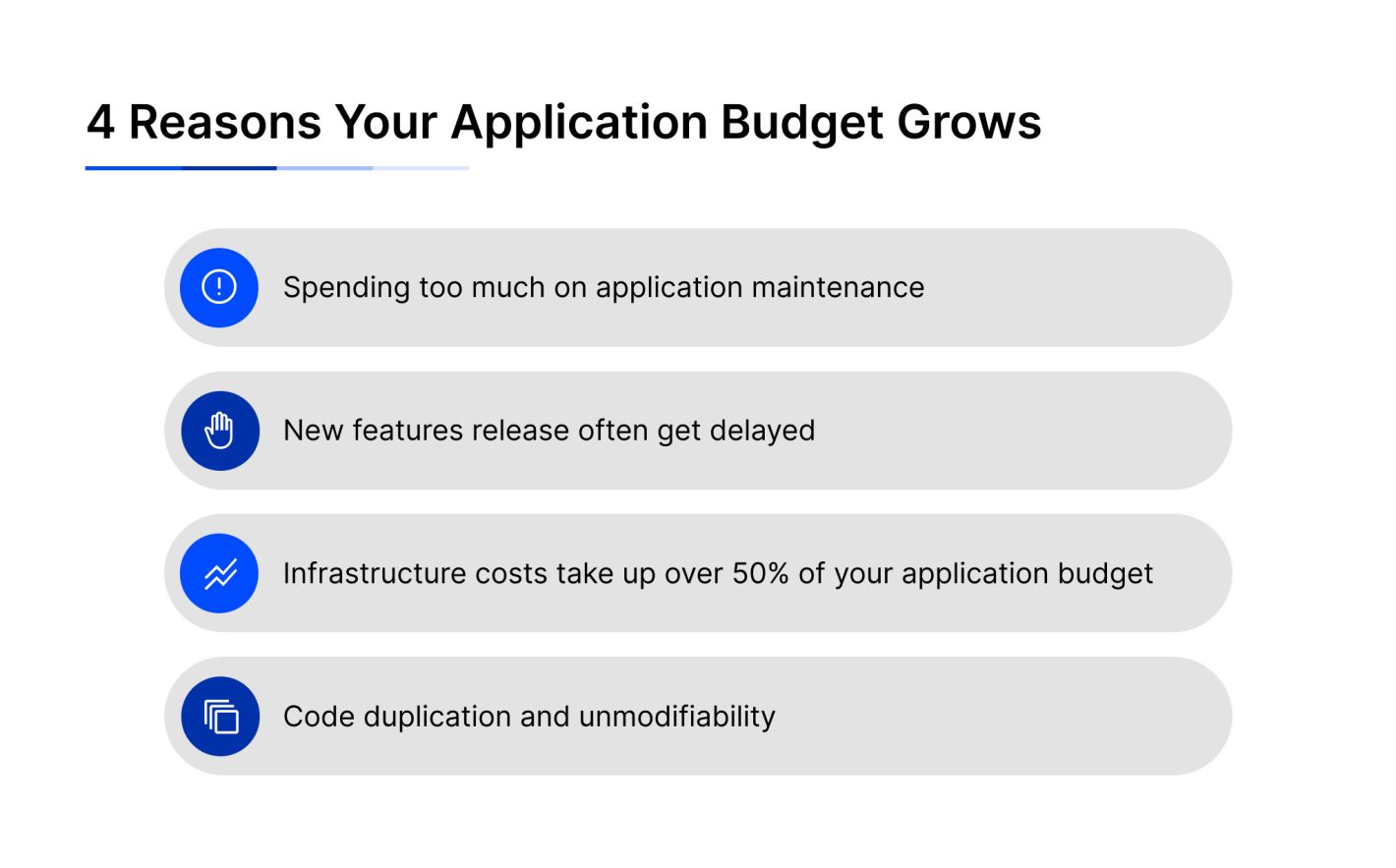
Bloated budget reasons
Working with our clients’ legacy enterprise applications, we have identified key reasons indicating application modernization is the way to go. Take a look here, do you see any familiarities with what you’re dealing with at the moment? Let’s get a detailed view of potential issues:
1. Spending too much on application maintenance
Let’s start with an obvious one: when was the last time you estimated how much you spent on application maintenance?
Legacy systems and outdated codebases often require continuous updates and fixes, increasing costs. Supporting these older systems demands significant resources that could be directed toward innovation rather than maintenance.
Shall we talk data now? A study by Stripe reveals that companies lose approximately $300 billion each year due to “technical debt,” as developers spend valuable time on maintenance activities such as addressing poor code, debugging, refactoring, and making modifications.
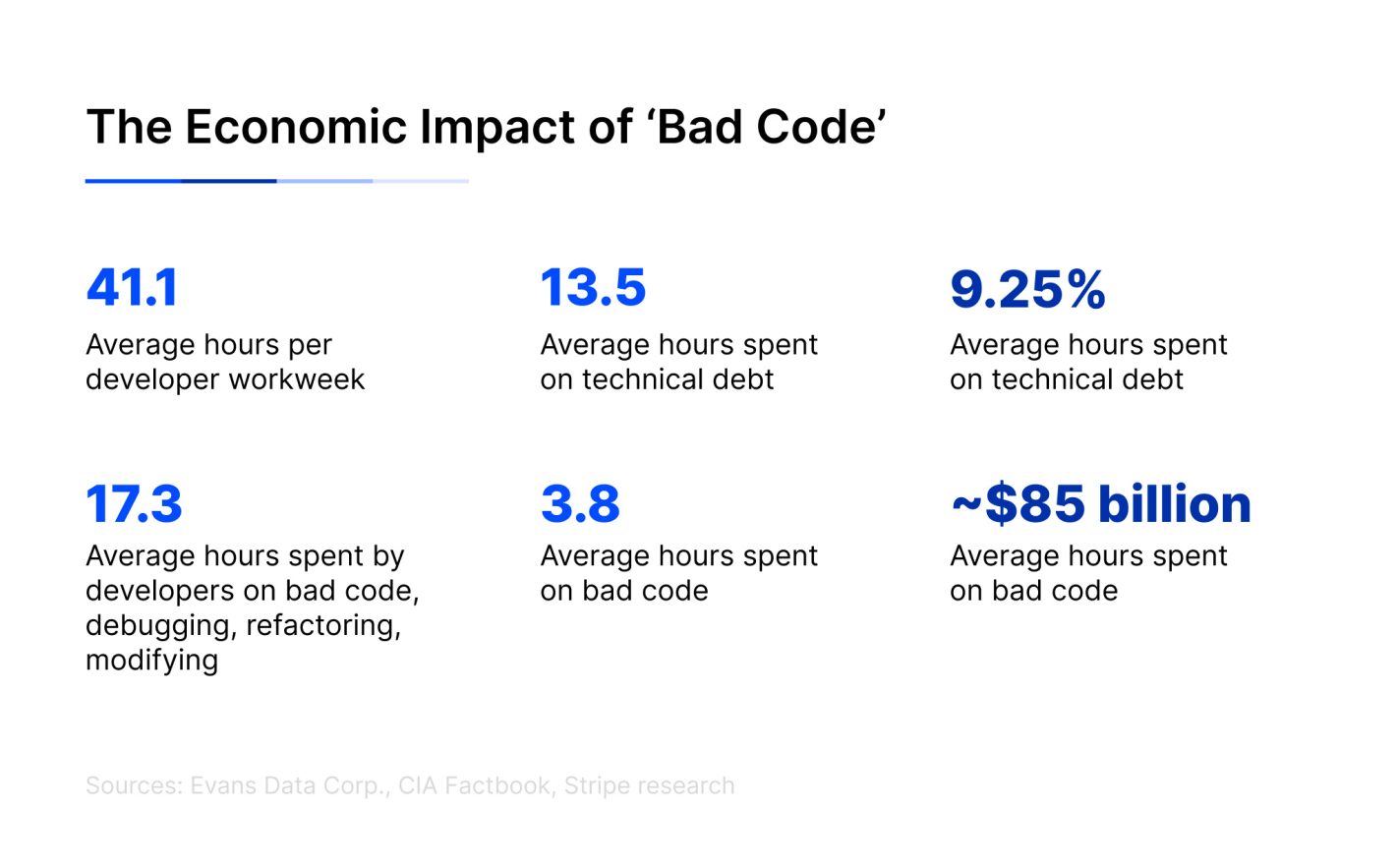
Economic impact of ‘bad code’
So, what’s your number?
2. New features release often get delayed
Have you noticed that something always comes up when you’re about to release new features? The answer is straightforward: market trends and customer demands continuously change, unlike your legacy system.
Lengthy development cycles often stem from complex code, inefficient workflows, or slow manual processes.
If that is the case for you, the Spotify story might hit closer to home. The company struggled to deliver new features rapidly because of the different tech stacks of their web player and desktop client and the complexity arising from context switching.
Moreover, the team had to release new features twice. That sounds like an extra budget and a valid reason for application modernization.
3. Infrastructure costs take up over 50% of your application budget
This one is pretty straightforward. An expensive infrastructure, whether cloud-based or on-premises, will strain your budget.
Poor resource management, over-provisioned instances, and unused services add to unnecessary expenses. With app modernization, you can reduce infrastructure costs by implementing scalable, pay-as-you-go models and optimizing resources.
Airbnb faced complex cost optimization challenges as the company started to grow. While AWS provided an agile platform to support Airbnb’s rapid expansion, it also posed dilemmas in managing resources effectively.
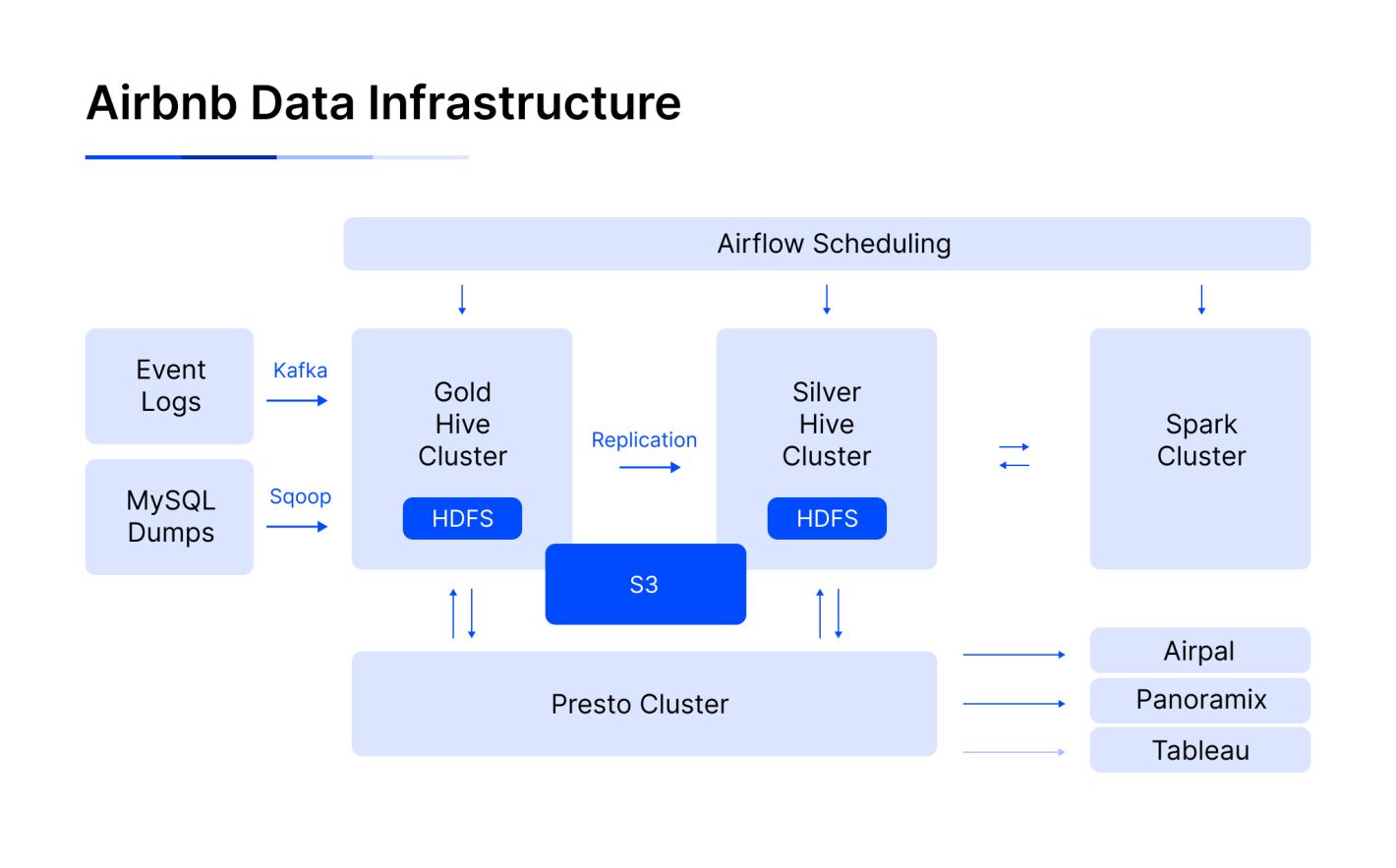
Airbnb’s cloud infrastructure
4. Code duplication and unmodifiability
Manual processes and redundant workflows slow down development and drain resources. Legacy applications often need to improve over time, like code duplication and inflexibility, outdated testing methods, or redundant manual tasks that can increase time and labor costs. Identifying and automating these processes can significantly improve resource utilization.
One of our clients, an American Flooring Company, realized that the budget for their ERP was growing. The reason behind this needed to be more trivial: manual data entry. Their employees manually converted handwritten notes into digital data, which resulted in mistakes and increased costs.
Therefore, Sombra helped to modernize the client’s 30-year-old ERP system and empowered them to go paperless.
Another thing we’d like to point out is using artificial intelligence in application modernization. AI can accelerate your app modernization efforts. So, always ask yourself how much value does it bring?
What App Modernization Solutions Can Help You Spend Less?
Identifying what exactly increasing your application budget is part of the solution. You need actually to modernize your software.
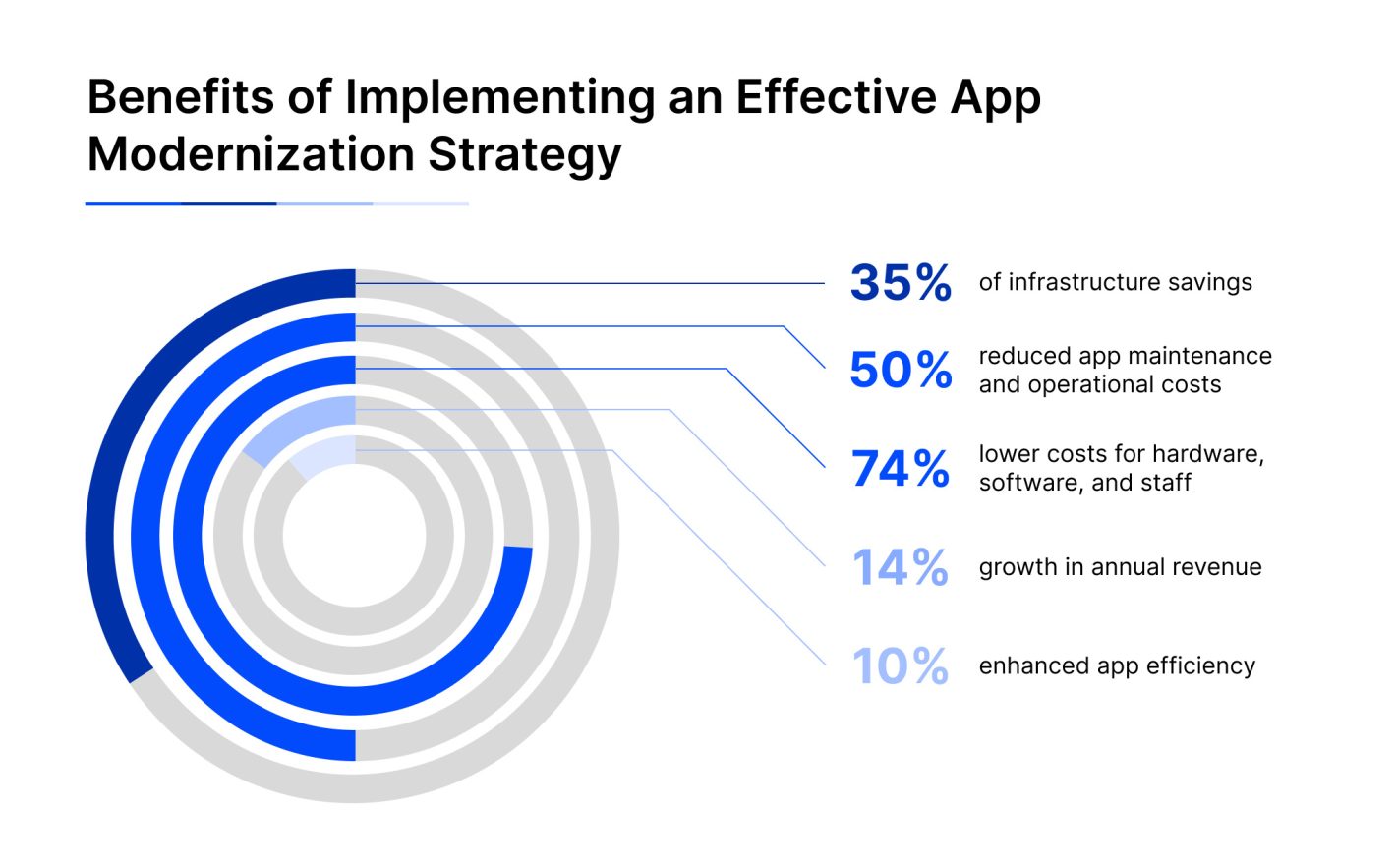
Benefits of app modernization strategy
According to IBM, companies that implement an effective app modernization strategy can expect:
- 35% of infrastructure savings
- 50% reduced app maintenance and operational costs
- 74% lower costs for hardware, software, and staff
- 14% growth in annual revenue
- 10% enhanced app efficiency
That is why we recommend analyzing the state of your legacy application and looking at the application modernization solutions below, which might actually become a part of your app modernization strategy and resolve some of your financial burdens.
Cloud resources optimization
Cloud optimization is essential for avoiding over-provisioning and under-utilizing resources. By identifying unused resources, optimizing storage, and adopting cost-saving measures, you can reduce monthly cloud expenses while maintaining performance.
We understand that it’s easier said than done. This section contains solutions that require the engagement of dozens of developers and hundreds of development hours. However, trust us; your team can implement them. Here are a few examples of how we at Sombra helped our clients. Most importantly, the results they achieved were obtained by implementing application modernization solutions.
- For US eClinical Technology Company, Sombra optimized data architecture and cloud resources, reducing infrastructure costs by 4x. This modernization effort included improving data processing, enhancing data security, and implementing a three-layer data structure for better analytics and reporting.
- With our Cloud Infrastructure Migration service, a Global Financial Organization has reduced its infrastructure costs by 50%. Migrating from on-premises infrastructure to the cloud not only cut costs for the client but also provided the flexibility and scalability necessary for future growth.
Contact us if you’d like to know more about our application modernization services.
Automating testing and quality assurance
Manual testing is time-consuming and expensive, particularly for applications that require frequent updates. Automating testing and quality assurance processes cuts down regression testing time, reduces human error, and minimizes post-deployment bug fix costs, ultimately leading to a faster and more reliable development cycle.
Code refactoring
Refactoring involves revising code to reduce complexity, making it easier to maintain and expand. This lowers long-term maintenance costs and accelerates future updates, reducing the time required for testing and debugging.

Source: Intel
Intel quotes a recent study that declares that when companies reduce their technical debt load by modernizing their legacy app portfolio, they realize immediate savings that amount, on average, to 32% of their IT budget.
Eliminating legacy components
Legacy components often require dedicated support, making them costly to maintain. By phasing out these elements and adopting modern alternatives, you reduce dependencies on older technologies and enable your application to scale more effectively, which reduces support costs and improves operational flexibility.
Using microservices
Decoupling monolithic applications to service-oriented architecture or even microservices per need allows businesses to scale components independently, saving on the testing and deployment stages of SDLC. Service-based architecture offers the flexibility to update individual services without affecting the entire application, enhancing modifiability and decreasing time-to-market.
Implementing DevOps and CI/CD
Automating development, testing, and deployment through DevOps and CI/CD (Continuous Integration and Continuous Deployment) practices speed up delivery and reduces errors. This streamlined workflow minimizes downtime and provides cost savings by avoiding disruptions associated with manual deployment.
Fanatics, a leading sports retailer, faced significant challenges with its legacy CI/CD tools, including unstable workflows, frequent disruptions, and time-consuming manual fixes. By transitioning to GitLab’s Continuous Integration (CI) platform, Fanatics achieved a stable and efficient development process.
The migration of 800 projects to GitLab eliminated recurring issues, enabling the cloud team to focus on innovation rather than troubleshooting. GitLab’s stability and advanced features, such as job scheduling and group-level environment variables, streamlined workflows, reduced downtime, and fostered collaboration across teams.
When to avoid certain modernization techniques
It would be totally unfair from our side to tell you application modernization is a one-size-fits-all solution. Situations in which application modernization won’t be a cost-effective solution exist. Here are just a few of them:
- Cloud migration isn’t always cost-effective: For companies with predictable, steady workloads, on-premises infrastructure may be more affordable than cloud solutions, which are best suited for fluctuating demands.
- Microservices complexity: For less complicated applications, microservices can add unnecessary complexity and infrastructure cost overhead. Smaller projects benefit more from a streamlined, monolithic approach.
Getting App Modernization Right: Key Components of Effective Application Modernization
Everyone talks about which tool to use for successful application modernization when we’d like to focus on the approach to maximize the outcome and get application modernization done right. To achieve that, we develop a tailored modernization approach that aligns with your specific budgetary and operational needs. It includes:
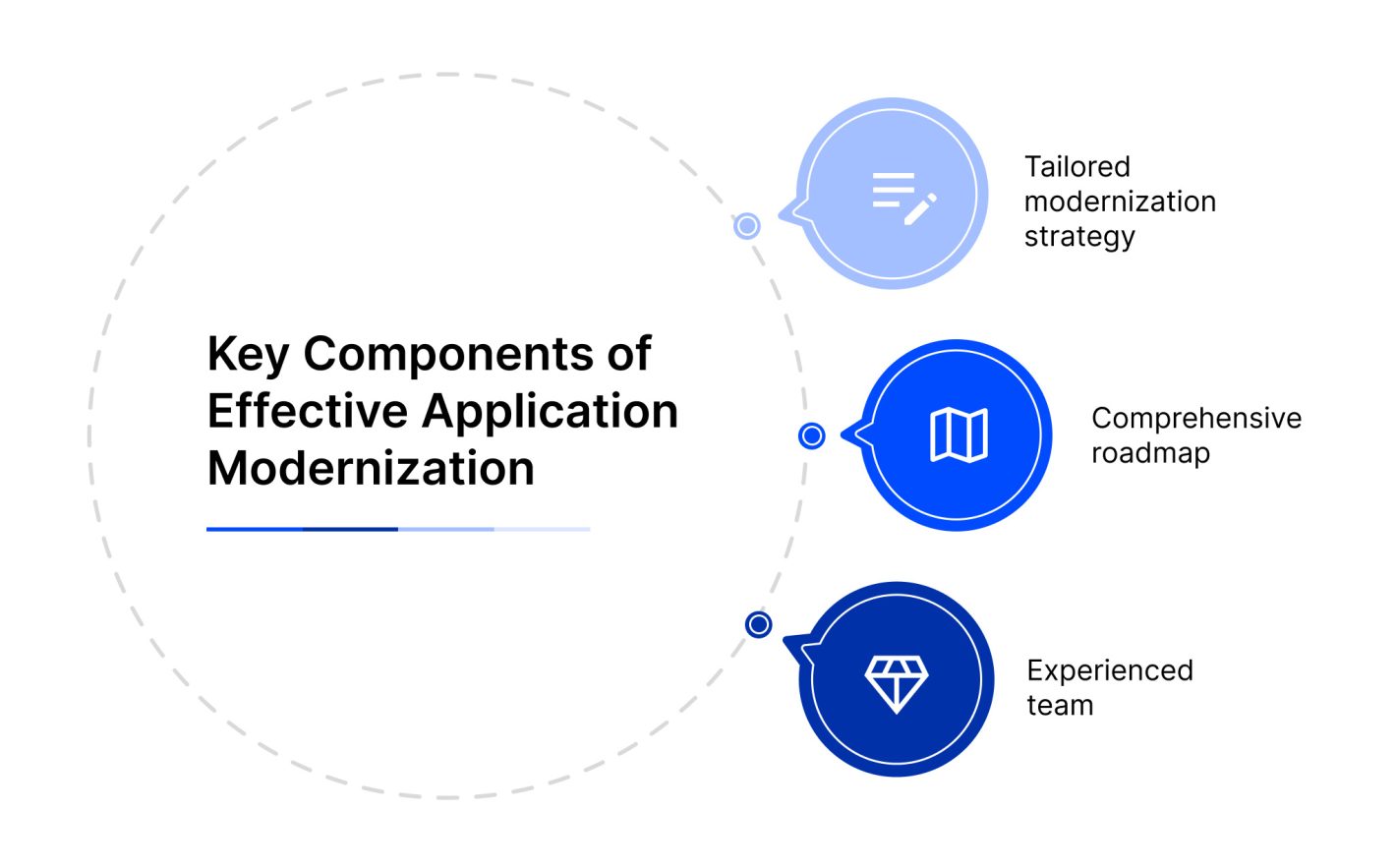
Key components of effective app modernization
1. Tailored modernization strategies
Sombra designs custom modernization plans to ensure your applications address your budget issues. We use industry frameworks and tools to evaluate the app’s existing state while building a modernization strategy, like ATAM, which is used for verification of architecture, identification of potential pain points applicable for application modernization, or tools like SonarCube and Snyk for static code analysis, quality and security assessment for further modernization.
We work closely with your team to understand your unique requirements and goals, creating a roadmap that optimizes costs without sacrificing performance.
2. Experienced team
Our team of experienced developers and consultants is well-versed in various cost-saving modernization techniques, from cloud migration and DevOps implementation to code refactoring and microservices. We recognize the intricacies of different industries and customize solutions to enhance cost efficiency.
3. Comprehensive roadmap
A phased modernization roadmap ensures your project aligns with your operational and financial goals. We provide a step-by-step plan that addresses immediate needs while planning for future updates to reduce costs over the long term.
That said, the right help can make all the difference. An experienced modernization partner can help you assess, plan, and modernize your apps.
By working with Sombra, you can leverage our years of experience across various domains and technical capabilities to reduce maintenance costs and create new digital capabilities for your business.
Final Thoughts
Outdated systems can quickly become financial burdens. Therefore, it’s about time to put a stop to the “if it works – don’t touch it” way of thinking and act to stay competitive in the market and survive as a business.
Implementing an effective app modernization can save you as much as:
- 35% on infrastructure
- 50% on app maintenance and operational costs
- 74% on lower costs for hardware, software, and staff
Finding the right application modernization company to work alongside you to assess, plan, and modernize your apps could help you avoid the mistakes that lead all your efforts to stall or underperform.
With Sombra, you can get a tailored modernization approach that aligns with your budgetary and operational needs.











